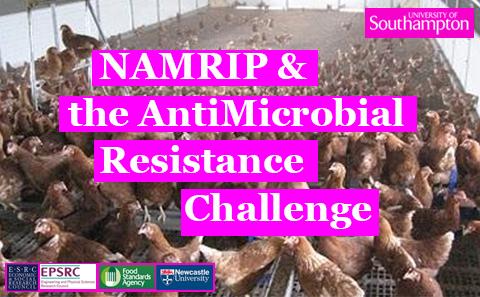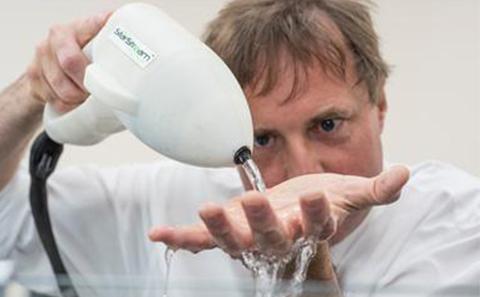
Read more from NAMRIP
Find out more about how the University of Southampton is tackling AMR

We are now familiar with the predictions of the Intergovernmental Panel on Climate Change, that by the end of the 21st century the increase in ‘greenhouse’ gases in the atmosphere will increase the average temperature of the planet by several degrees Celsius, reduce snow and ice cover, change patterns of precipitation, increase the acidity of the oceans and raise sea levels, increase the intensity and frequency of extreme weather events, with commensurate effects on human health, migration patterns and security, resource availability, and ecosystems in general.
By the time this apocalyptic scenario arrives, the grandparents of that generation will recall an apocalypse that arrived when they were children, fifty years earlier, and which continued to worsen in the years 2050-2100.
It is now commonly cited that UNLESS measures are found, AntiMicrobial Resistance (AMR) will by 2050 be killing more people than cancer, and cost more than the current global economy. Food production will fall unless we wean food supply chains off of antimicrobials. Common medical procedures, from childbirth to catheterization, will become more hazardous. Advances in treatments, such as those for childhood leukaemia, will become reversed.
Perhaps the most important word above is not ‘apocalypse’, but ' unless'.
Let us consider two extreme views of the interpretation of ‘unless’.
The most optimistic interpretation implies that new antimicrobials will outpace AMR by arriving in a timely sequence as a result of research and remaining effective through improved antimicrobial guardianship (not acceding to patient demands, and stopping counterfeit and over-the-counter/internet trade).
In the most pessimistic view, we reach a point where antimicrobials do not work.
Which view most resembles the prevailing one?
I suggest that, in referring to a ‘$2bn global antibiotic research fund’, a global consensus and the ‘answer to antibiotic resistance (could this be the end of superbugs?)’, we are implicitly taking the most optimistic view. This might leave us unprepared for a worse outcome.
Taking the most pessimistic view would prepare us for this, and provide a ‘mix-of-measures’ that extend the lifetime of future antimicrobials, but would divert current research funds. The current optimistic plan must be tempered by putting in place sufficient measures to allow us steadily to evolve our processes, behaviour and technologies enough to manage the challenges AMR will present in 2050. Diverting some resources to the pessimistic approach is wise because of:
In his 1945 Nobel Prize acceptance speech, Fleming predicted: ‘The time may come when penicillin can be bought by anyone in the shops. Then there is the danger that the ignorant man may easily underdose himself and by exposing his microbes to non-lethal quantities of the drug make them resistant’. Despite seven decades of warning, we have today no idea what the ‘solution’ to AMR looks like: a single approach (as antibiotics gave us) is less likely than a mixture of gadgets, processes, behaviour and chemicals. This mix-of-measures is unlikely to be a ‘solution’ so much as an ongoing coping tactic. Failure to find a solution given 70 years to prepare, suggests it is unwise to assume the optimistic stance, and underfund the pessimistic view. Since we cannot even conceive the shape of ‘the solution’, we should buy ourselves time to draw up that mix-of-measures by improving guardianship – but this is vastly more challenging that the optimistic view suggests (as illustrated below by the examples of pet owners and farmers). The allocation of funds is not in itself a strategy. The correct identification of the key specific problems, the selection of powerful solutions that can be taken up given the context of the above problems and the inherent constraints facing users (in infrastructure, training, culture, resources etc.), and plans affordably to translate solutions to 7 billion people and their animals, are vital.
The authoritative, optimistic AMR-Review reports propose interventions for new antibiotics, diagnostics, vaccines, and environmental action. However, the pessimistic view requires a high-volume, low-cost adventurous research for the mix-of-measures that would prepare us for a world where antibiotics are largely ineffective. In the most optimistic case, that mix will extend the period of a new antibiotic before resistance comprises it, and in the most pessimistic case it is the only option.
To envisage how improbable the optimistic outcome is, consider a plan that mandates that 5 years hence we stop all antibiotics for pets (and in that period trial candidates for our ‘mix-of-measures). Five years after that we stop all antibiotics for commercial livestock, and translate successful practices from pet trials to food production and healthcare; and phase in, say, a doubling of food prices to accommodate AMR livestock, arable, soil and retail issues and give farmers extra staff and training, new diagnostics, novel cleaning techniques, new surfaces and materials, better communication, infrastructure and understanding of contamination routes. How palatable is that for an electorate over 3 election cycles, especially if it is not implemented across nearly 200 national governments? Realistically, how do you restrict antibiotic provision to a £100 million racehorse? Measures to offset a ruthless future (where procedures using antibiotics today are on a future excluded list) will require more grit than simply allocating funds.
A ‘new antibiotic’ without AMR is unrealistic. The mix-of-measures will be an ongoing coping tactic to enable us to function at the current level of healthcare and food production because its guardianship is ingrained and sustainable. To develop this (currently unknown) mix, it is vital that we maintain an EXPLORATION research phase, where small look-see research projects explore new ideas and new collaborations, rather than quickly reverting to the traditional CRYSTALLIZATION phase where we take the prejudged view of established researchers on which projects will ‘solve’ the problem of AMR, and heavily fund a smaller number of these. This denudes the primordial soup of new ideas, and focuses resources on legacy opinion, a route that has not succeeded for established research councils and groups following Fleming’s 1945 warnings.
Currently, a multitude of separate UK research councils fund AMR, and for each (and their reviewers) aspects of AMR remain out-of-remit. Fundamental projects with an impact plan can flounder, because engineering reviewers believe they should not fund clinical trials, and medical reviewers believe they should not fund new inventions, and both believe that a 4-year plan to conduct research and follow it up with manufacturing places research at too high a technology readiness level (TRL). We need such projects, because AMR grows so quickly as to leave the traditional route of publishing research, and expecting others to discover that publication and make all the impact from it, too slow. Furthermore, we need truly multidisciplinary thinking: every year we hear of a few cases of food poisoning by E.Coli, which embarrass the retail sector - in 15 years those embarrassments will be fatalities because E.Coli has evolved resistance strains which are spreading at a phenomenal rate. How do we fix that? By engineers inventing better food cleaning methods, by microbiologists having more rapid methods to detect microbes, by managers working out how transporting and storing food is allowing contamination to occur, by social scientists working out how our need for convenient food overrides our need to protect ourselves from infection … and none of these people can work in isolation. We must have teams that talk to each other across disciplines, which work together, so that when you look at the young people who will be leading research in 10 years, you cannot tell if this was an engineer who learned microbiology, or a microbiologist who learned engineering.
We will never stop the rise of superbugs… but by preparing how to live in a world without antibiotics and other antimicrobials, we will discover the processes and technologies people need to use as an alternative in food production, petcare, and human healthcare. People will not change behaviour without viable, affordable options. Those options must be designed to maximize sustainability from the start, factoring in how to best to guard against resistance to it, and estimate how long such efforts will last. Research Councils must embrace visions that span TRLs, rapidly advancing game-changing fundamental researcher into mass production. Furthermore, they should address the development of the future multidisciplinary workforce needed to work on AMR : Councils have differing opinions on researcher co-investigators, which thwarts efforts to nurture the multidisciplinary researchers who will lead AMR research in 10-20 years. Established research groups formed from commonality of topics, whereas we must support networks of young multidisciplinary researchers must be brought together by commonality of the problem they face (AMR), regardless of the topics they work in.
In the UK we need a single unified research-and-translation council, and a single government body, to adopt AMR, because current organizations all have key strands in the AMR web that are out of their remit. The allocation of funds, and implementation through existing funding mechanisms, represents an optimistic view. Resourcing a pessimistic view both prepares for the worst and extends the lifetimes of new antimicrobials.
Professor of Ultrasonics and Underwater Acoustics, University of Southampton
15 December 2016

Find out more about how the University of Southampton is tackling AMR